A few weekends ago I visited a couple of American friends living in London, including one of my oldest friends, Cecily, who is also an art historian. Cecily is 4’11 and I am 6’3. This fact is not at all relevant to the rest of this essay, but I feel the need to announce the discrepancy between our heights any time Cecily comes up. Opposites do attract.
Anyway, Cecily’s two older sisters were also visiting for the weekend, and she invited me to join them on a Sunday day trip to Charleston House, a short journey outside of London in Sussex County. Upon receiving the invitation, I promptly Googled: “What is Charleston House.” A quick skim of the internet informed me that the house was a meeting space for some sort of artist commune that any good art historian like myself should be familiar with. Being the good art historian I claim to be, I enthusiastically agreed to join Cecily and her sisters on their adventure to this sacred space I knew so much about and had always been dying to visit.
Initially, the trip was going to consist of a fairly large group, including a handful of Cecily’s friends and my friend Jemma. But as the responsibilities of the coming week crept closer in the shadow of Sunday Scaries, most backed out. The final roster for our adventure ended up being a small and unlikely group: Cecily, her sisters, my friend Jemma, and me.
As I have gotten older, I have learned that group dynamics can easily pique my anxiety. I often care (too much) about the comfort of those around me. On my 22nd birthday, for example, I spent much of the time stressed that friend X and friend Y were not enjoying each other’s company at the dinner table (a good lesson in why place cards exist). With time (and therapy!) I have learned that these sort of dynamics and peoples’ general merriment will not always be in my control. But, like most wisdom, this is easier stated in the abstract than acted upon in reality.
Therefore, as Jemma and I took the tube to meet Cecily and her sisters at the train station on Sunday morning, I found myself a little nervous. I had not spent extended periods of time with Cecily’s sisters, and Cecily’s sisters had spent no time with Jemma. Cecily and Jemma had only met on a few occasions, through me. What if, I wondered, we found ourselves in the middle of the remote countryside, at some random artist house, and it was awkward. Worse yet—what if we actually all hated each other’s company. Even worse: what if they all turned on ME since I was the one who tied this makeshift group together and then they abandoned me in the woods to fend for myself and then I ran out of water and food and then I froze to death thousands of miles away from my family?! And the ultimate worst case of all: what if someone asked me to explain the significance of Charleston House and my Google knowledge failed me and I was exposed as a Wikipedia reliant art historian FRAUD and my career was destroyed forever!?! (This, dear readers, is what they call Catastrophic Thinking).
Although the train ride was filled with good banter and easy conversation (and no indications of an impending coup d'état), Mr. Anxiety lingered by my side as a taxi took us from the Lewes train station into rural farmlands. However, as we drove up the winding dirt driveway of the Charleston House, and as the quintessential country cottage emerged out of the grey mist, my worries dissipated.
When we entered the house, an incredibly welcoming staff of enthusiastic docents (who expected absolutely no prior knowledge) quickly helped me understand the historical context of where I was. Charleston House, they explained, was a home and meeting space for members the Bloomsbury Group, or a group of associated English writers, intellectuals, philosophers and artists in the first half of the 20th century. This group included the artist Vanessa Bell and her sister, literary icon Virginia Woolf, along with influential art critic Clive Bell, artist and critic Roger Fry, artist and textile designer Duncan Grant, and fiction writer E.M. Forster— among others.
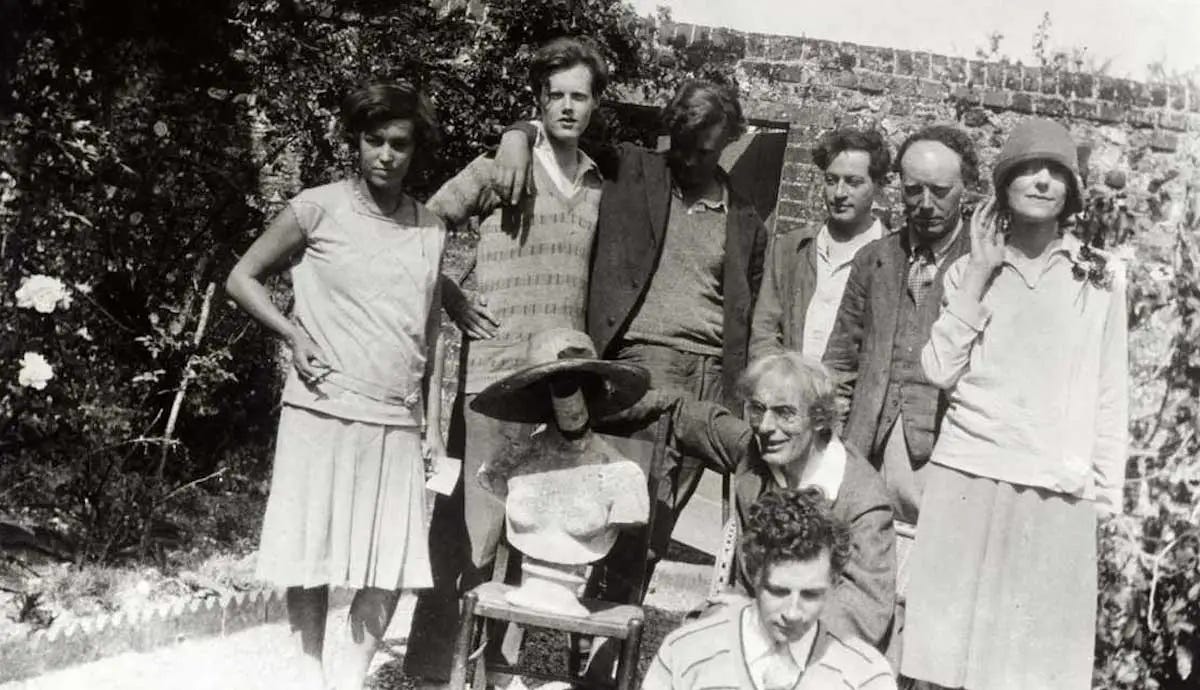
During the First World War, Vanessa moved from London to Charleston House with Duncan, her partner at the time. When Vanessa arrived the farmhouse was run down and, on a technical level, stuck in the past. There was no telephone, no radio, no electricity, and no central heating. Yet the progressive ideas and spirit that soon inhabited the house propelled it far beyond the time period its infrastructure would suggest.
This was clear from the home’s interior alone. Instead of presenting subdued remnants of opulent Victorian décor, or perhaps the tidy, Mock-Tudor design that one may expect to find in a 1916 country house, the Charleston farmhouse’s interior is defined by a system of organized chaos— an exciting flurry of color, patterns, and objects that could entertain one’s eye for hours on end. Nearly every surface within the home seems to be painted. Abstract patterns dance across door panels and table surfaces, or along the mantels of the fire places. Doodles decorate cabinets and headboards while stunning murals grace the sides of bathtubs. Abstraction and figuration coalesce—in a time when figuration was still valued in the world of fine arts.
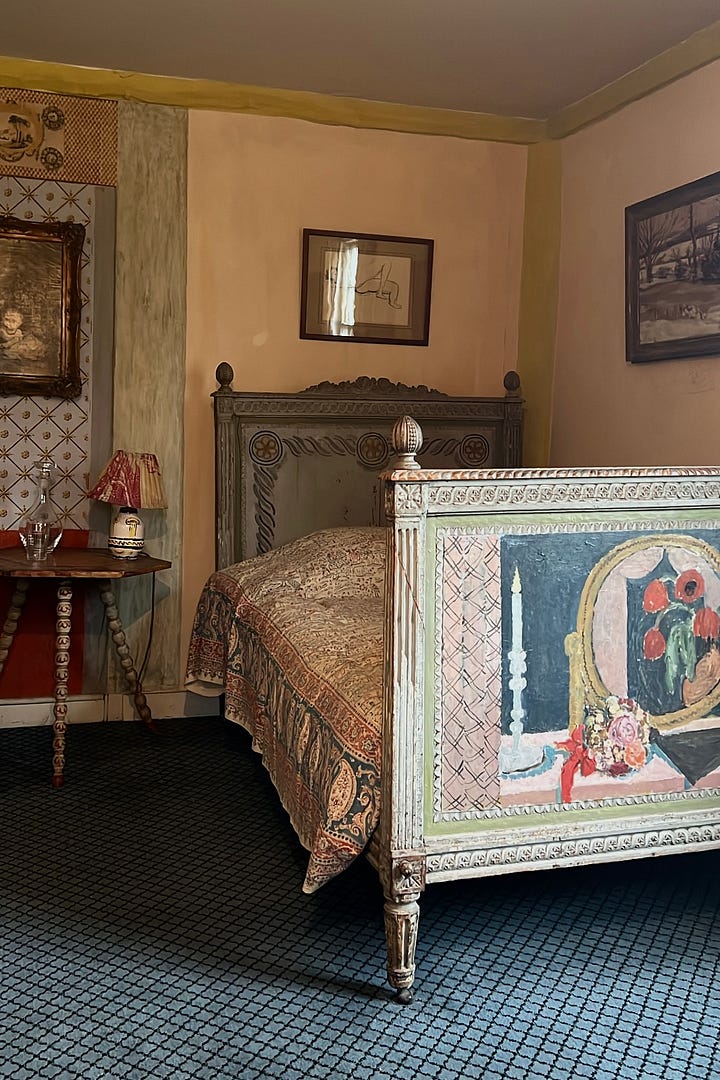
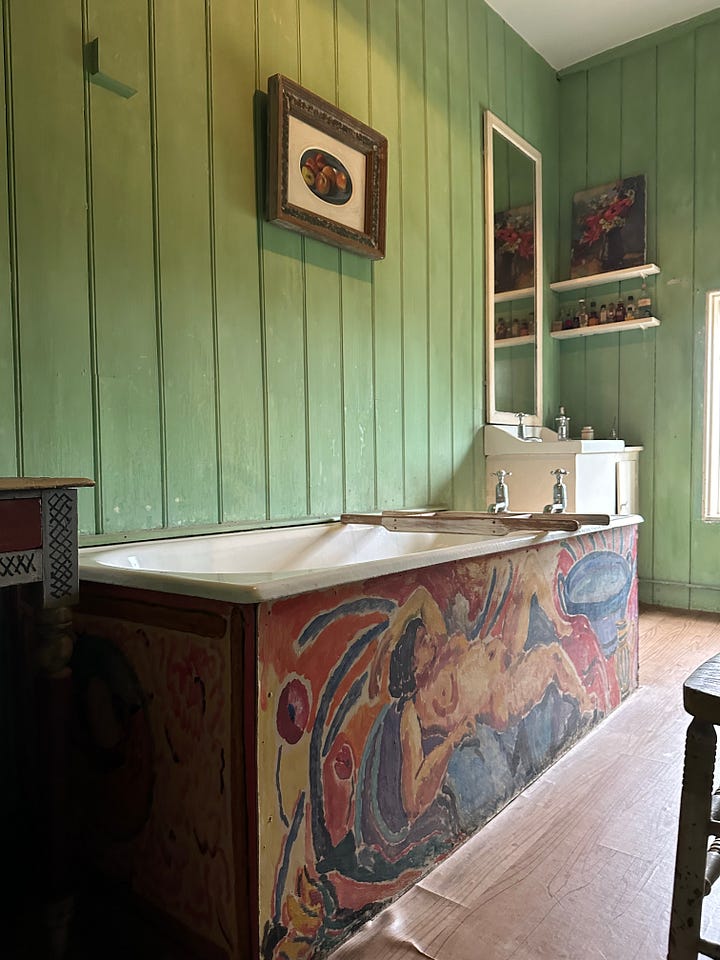
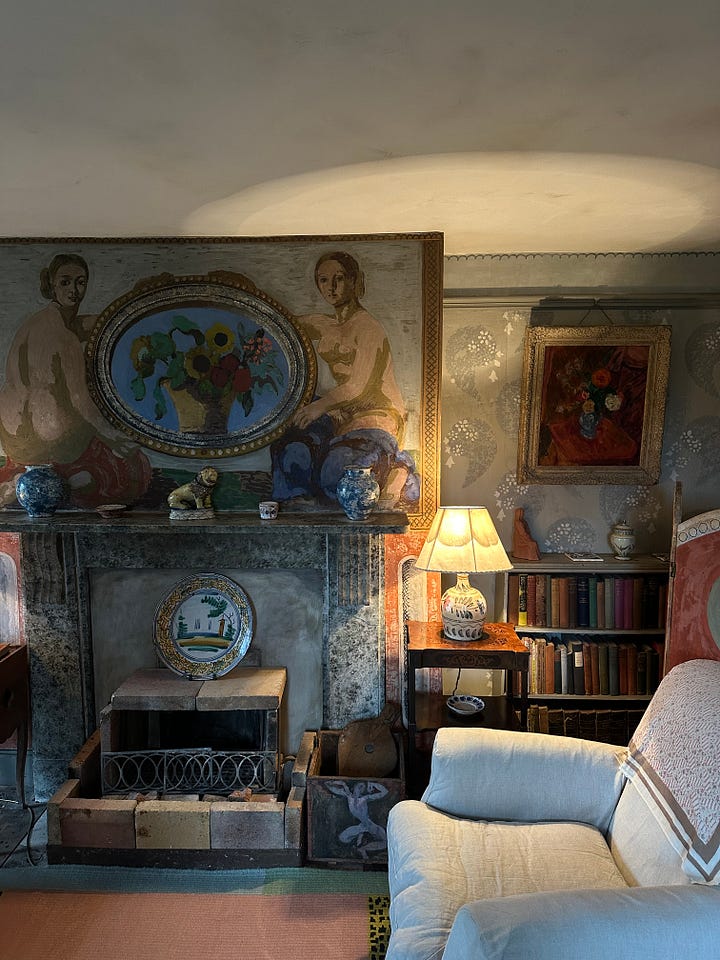
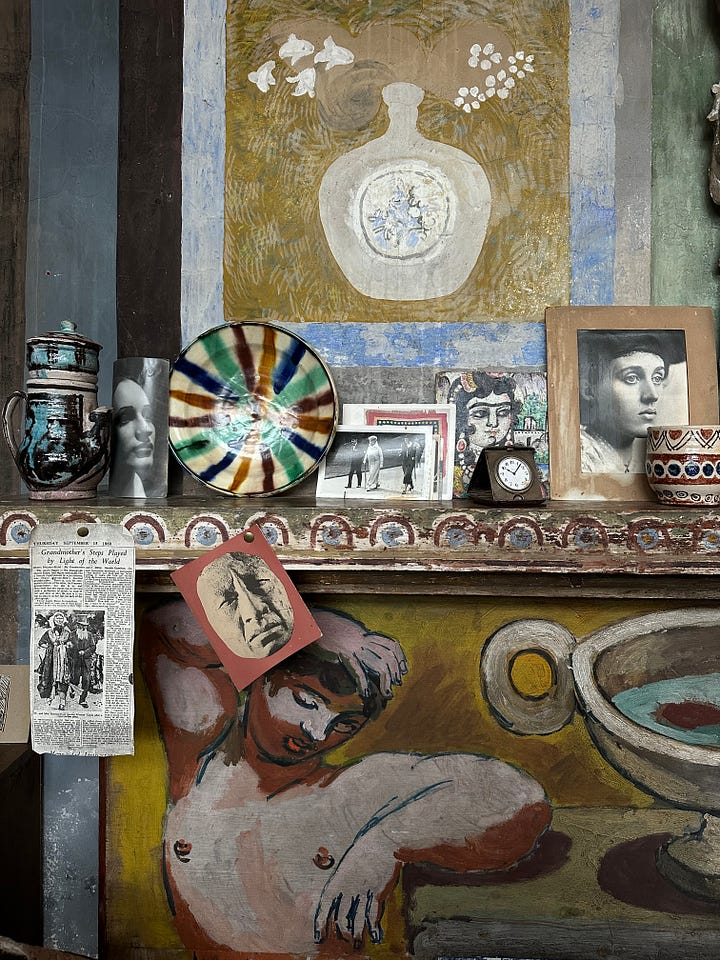
Any aspect of the home that is not painted either houses a painting or is raised to the status of an art object through its idiosyncratic presentation. Vibrant textiles decorate cushions and turn rugged lounge chairs into boldly decorative statements. Quirky, one-of-a-kind ceramics (or are they maybe upside down, painted colanders?) hang from the ceiling as spunky lamp shades. Shelves overflow with colorfully bound books. A studio with high ceilings and gaping windows overlooks a garden in the back yard. An empty Tanqueray bottle abandoned next to dried up paint tubes glistens in in the icy light pouring in from outside. The walls glow with contrasting applications of streaky pigments, apparently applied with brooms turned paint brushes. Newspaper clippings and vernacular photographs are pasted upon mantelpieces, alongside what seem to be the proudly displayed drawings of one’s child (likely the daughter of Vanessa). Letters and manifestos sit half written in typewriters.
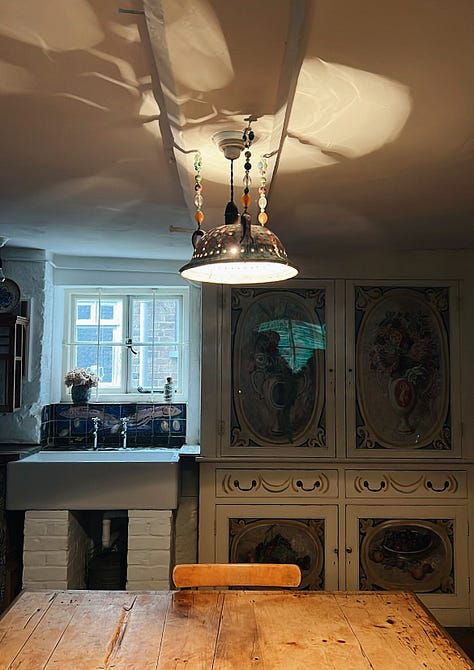
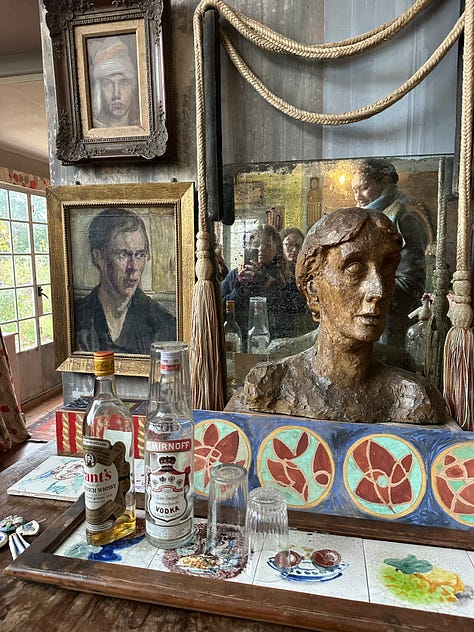
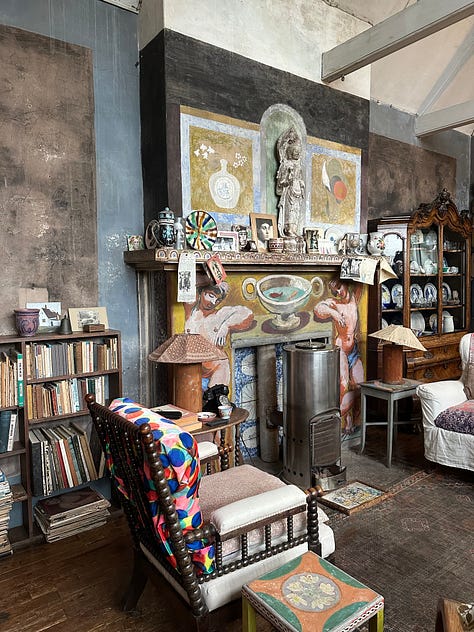
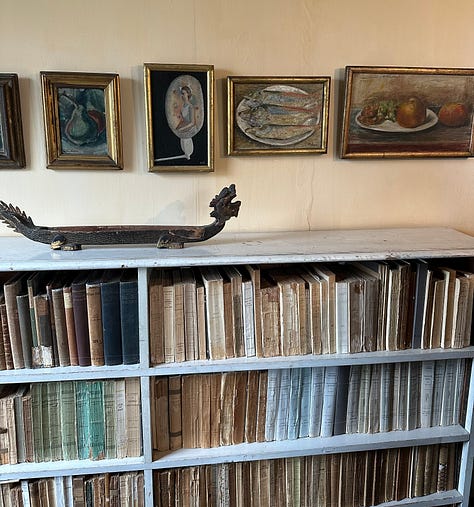
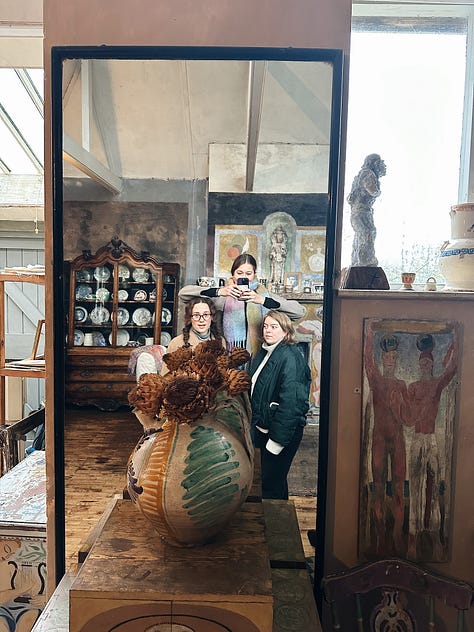
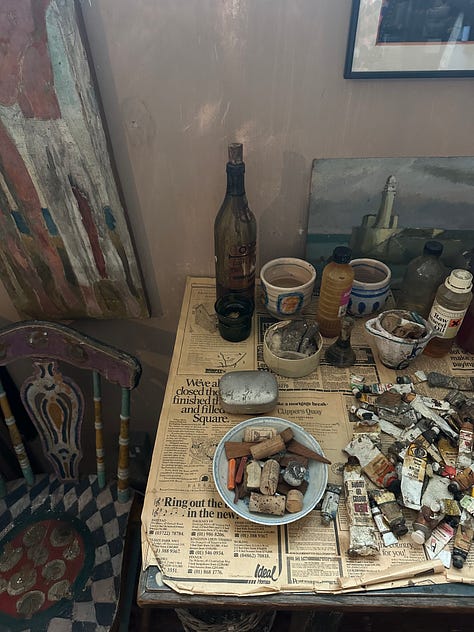
The lifestyle and ideas of the people who inhabited Charleston House were as bohemian as the home’s interior. One nearly needs a pen and paper to keep track of the constantly shifting dynamics between friends and lovers; Vanessa’s marriage to Clive, her affair with Roger Fly, her eventual partnership with Duncan— who, despite being homosexual, was the father to their daughter… who believed Clive to be her father.
Despite the lack of radio, the politics of World War I were a common topic of conversation within the home’s walls. In fact, the house’s location was strategic in this sense as it allowed Duncan—a pacifist and conscientious objector of the war, like many within the Bloomsbury circle— the opportunity to work on nearby land in order to avoid fighting in the army.
Avant-garde discussions within the realm of art and criticism occurred alongside those of politics. Roger Fry, for example, championed British modernism, promoting the work of Cézanne and curating exhibitions that introduced the art of contemporary artists such as Matisse and Picasso to England—thus changing the trajectory of British art and ideas forever. Clive Bell further emphasized form over content— ideas that are visually manifested in the abstract renderings decorating the side tables and panelling across Charleston House. The modernist writing of Virginia Woolf mirrored the artists’ interrogation of traditional form and customs. Even economist John Maynard Keynes found, within the home, the mental stimulation necessary for his own line of intellectualism within the seemingly contradictory world of economic theory and reason (Jemma, a former banker, was thrilled to hear that the famed economist also found solace in the home during his day).
The Bloomsbury Group was naturally criticized. Their boldly eccentric and openly revolutionary ideas were often seen as enabled by their wealthy backgrounds and, therefore, their inherent privilege and confidence. Nonetheless, it is hard to deny that the home this group built—with its vibrant appearance and its lasting energy—is an incredibly unique space of inspiration and discovery.
As the five of us walked through the house, we found ourselves transported to an often overlooked, vibrant corner of history. We shivered within the poorly insulated space as one can image the Bloomsbury members once did, but we nonetheless found ourselves warmed by the ghosts of their rebellious ideas and subversive forms of art making, which blossomed from every corner.
When we left the house, we were still buzzing with awe. We trekked up a muddy path along the damp farmlands and into the woods, determined to get the authentic countryside experience (and to save cab money) by walking to a Sunday roast at a nearby pub in Firle. We destroyed our shoes and I, at one point, got stuck in a thorn bush attempting to avoid a particularly swampy patch or the trail. But our excitement from the aesthetic and intellectual discoveries of the Bloomsbury Group’s home kept our spirits high.
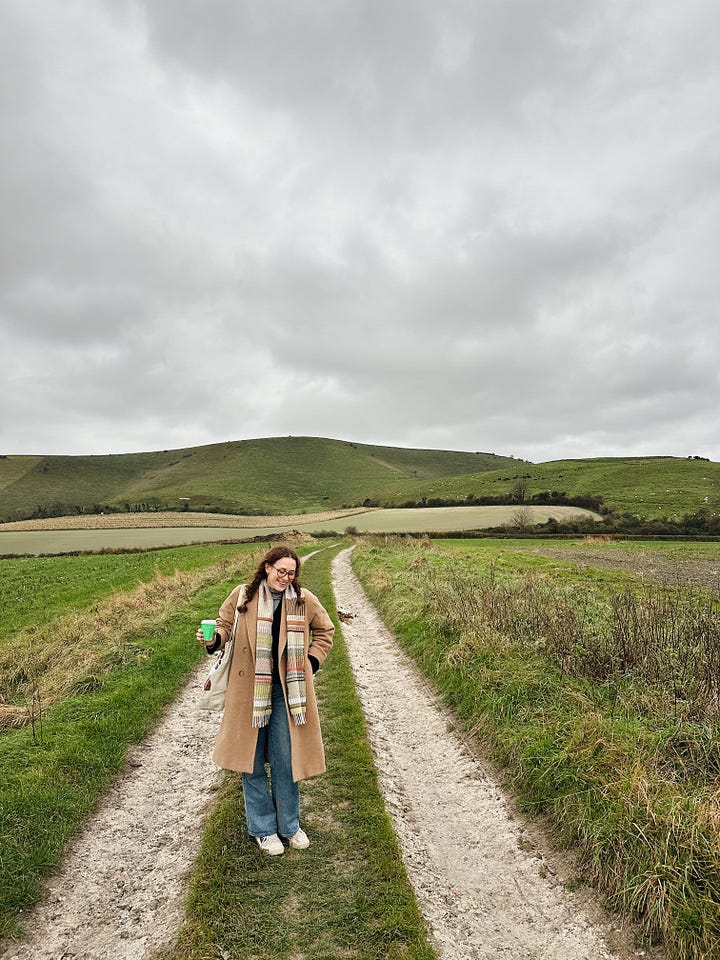
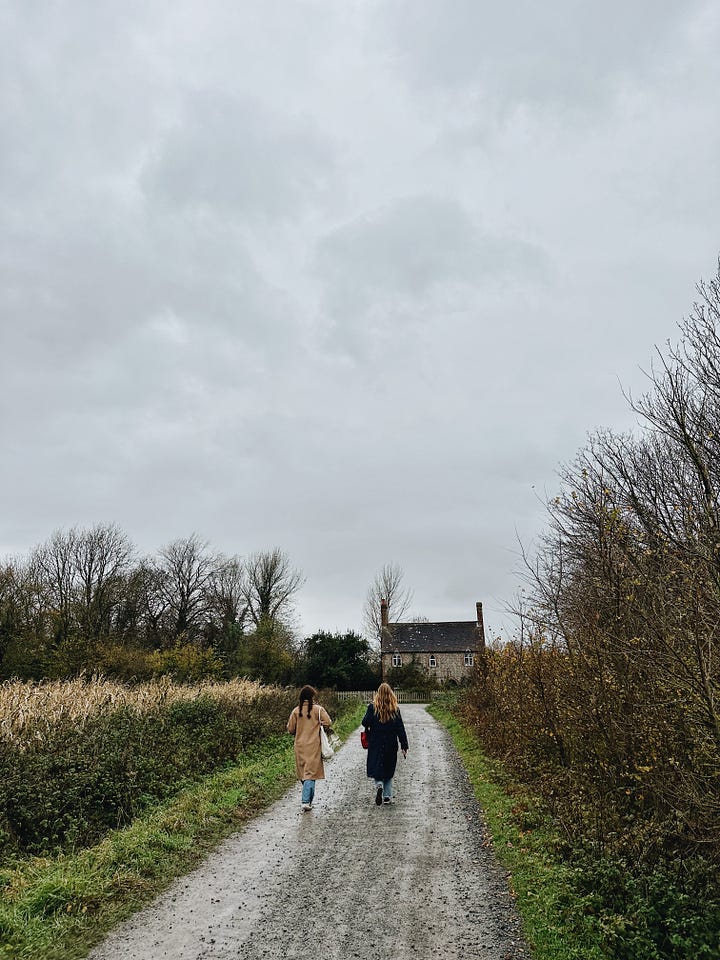
Why, we asked as we walked, does society mandate that we settle down to live with a single partner? Why don’t we live with our friends in a home overflowing with intellect and discussion of all forms, in which we paint every surface as we please? Why don’t we all live together? In fact, why don’t we just start our own artist collective?!
And what, we further questioned, would the Bloomsbury Group think of today? We decided they would be pleased with certain aspects, as they were ahead of their times in the early 1900s. Yet, in many ways, we also now find ourselves struggling to keep up with theirs.
Later, in the warmth of the pub’s bustling atmosphere of locals, it was hard to tell if the carafes of red wine or the spirit of the house kept our cheeks flushed and our heads light. Earlier in the day, someone brought up New York Time’s 36 questions to help you fall in love— a list of 36 questions formulated by psychologist Dr. Arthur Aron in 1936, with the aim of creating intimacy between strangers. One of us suggested we try them out.
As we scarfed down steaming plates overflowing with meat, potatoes, and pickled vegetables drenched in gravy, we took turns answering the questions. Would we like to be famous? Do we fear death? Do we rehearse telephone calls before making them? Do we want to know our future? What memory do we treasure the most? What would we change about our childhood?
Although we hardly got half way through the list, I have a hunch that we all felt a certain form of love. A love for a perfect day of discovery, and a love for the individuals that made the effort to seek out and embrace unassuming adventure.
I think we have Charleston House to thank for enabling this feeling. The home provided a place to feel comfortable with strangers; a context for discovery; a space for continuous stimulation; an oasis from the conventions of society; a reminder that unpredictable group dynamics can be just as exciting as they are terrifying. A reason to be open to falling in love with those around us as we create our own artist communes everyday, everywhere.


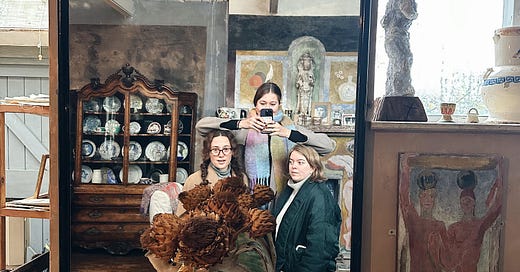


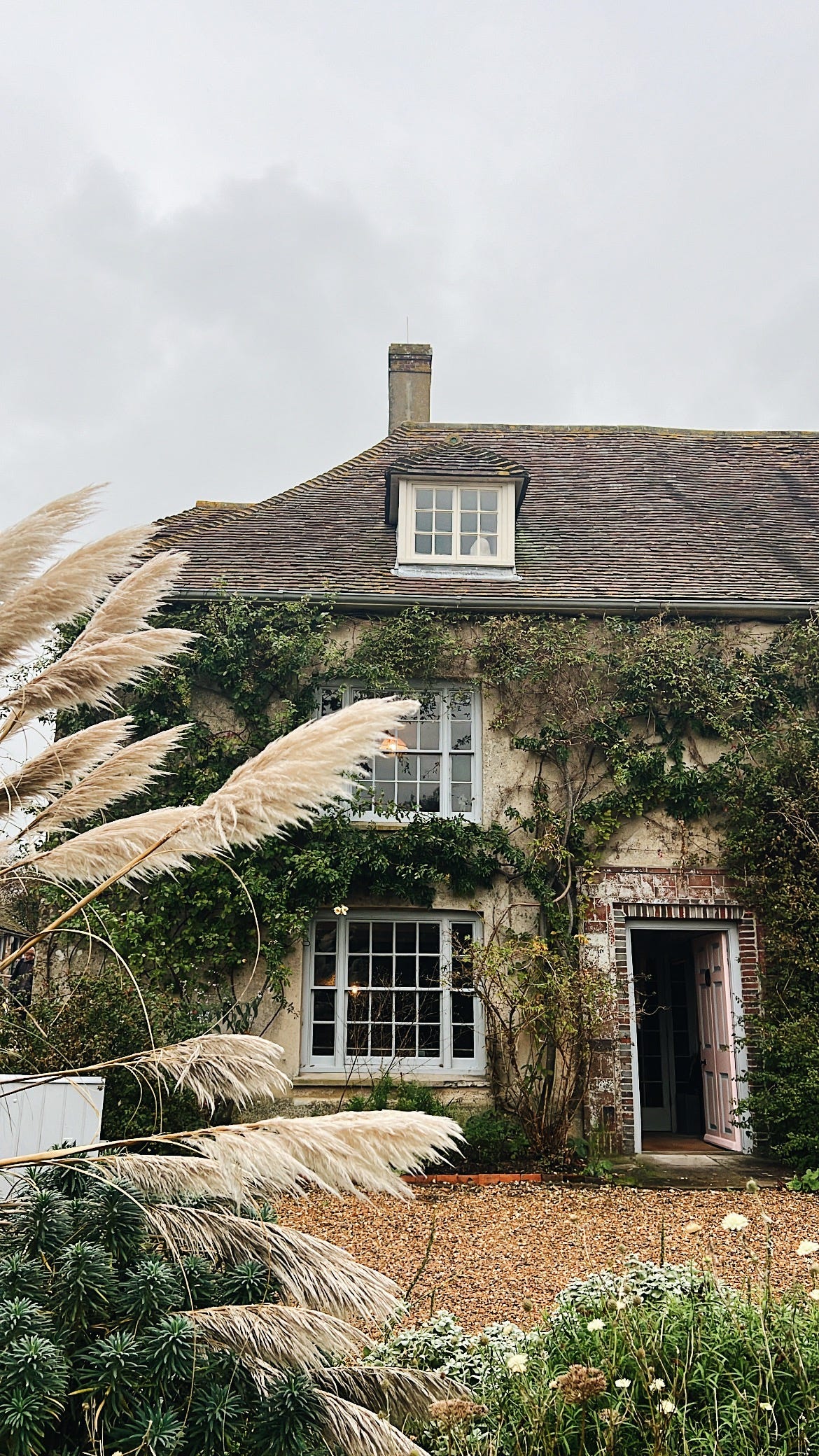
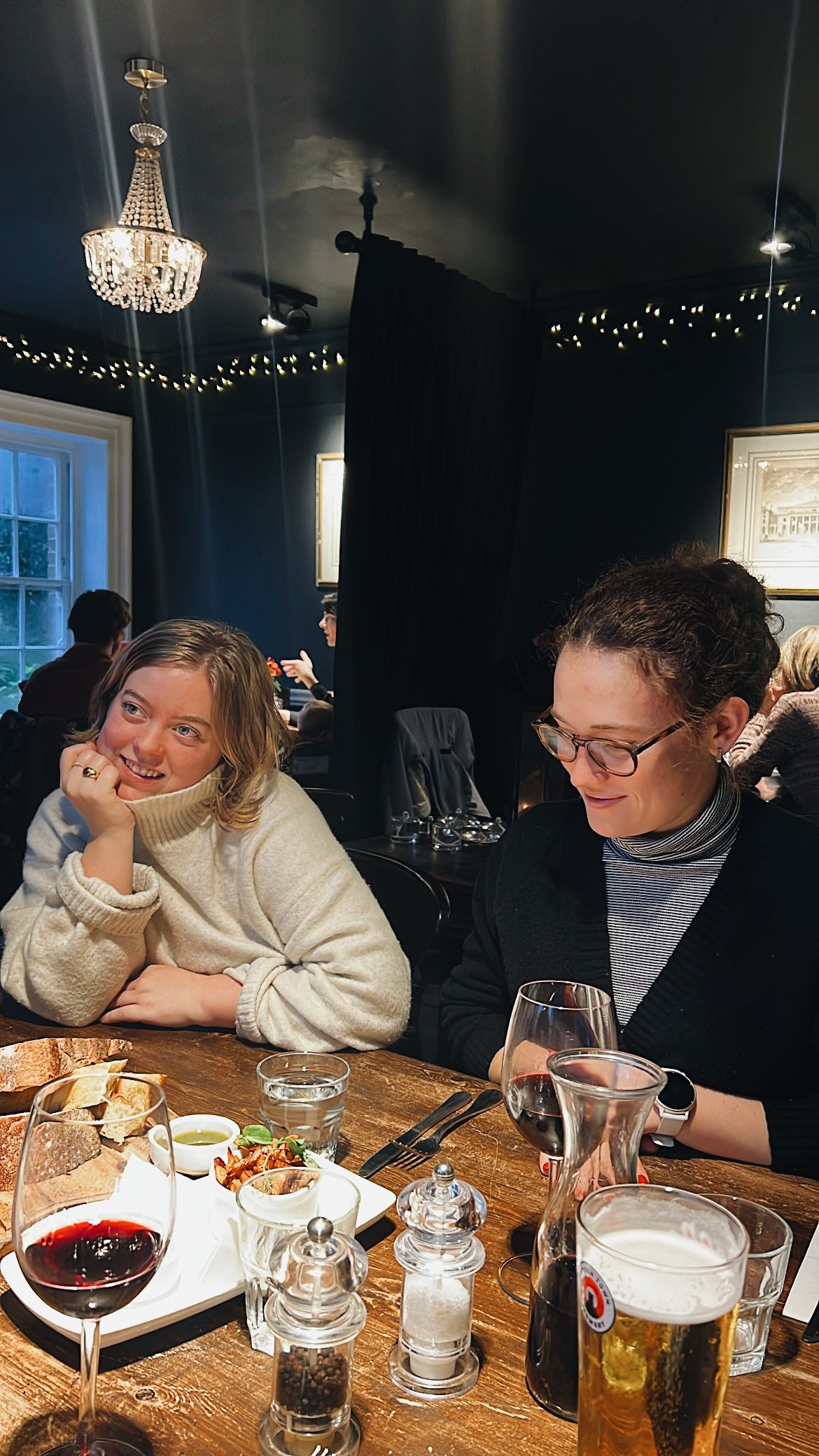
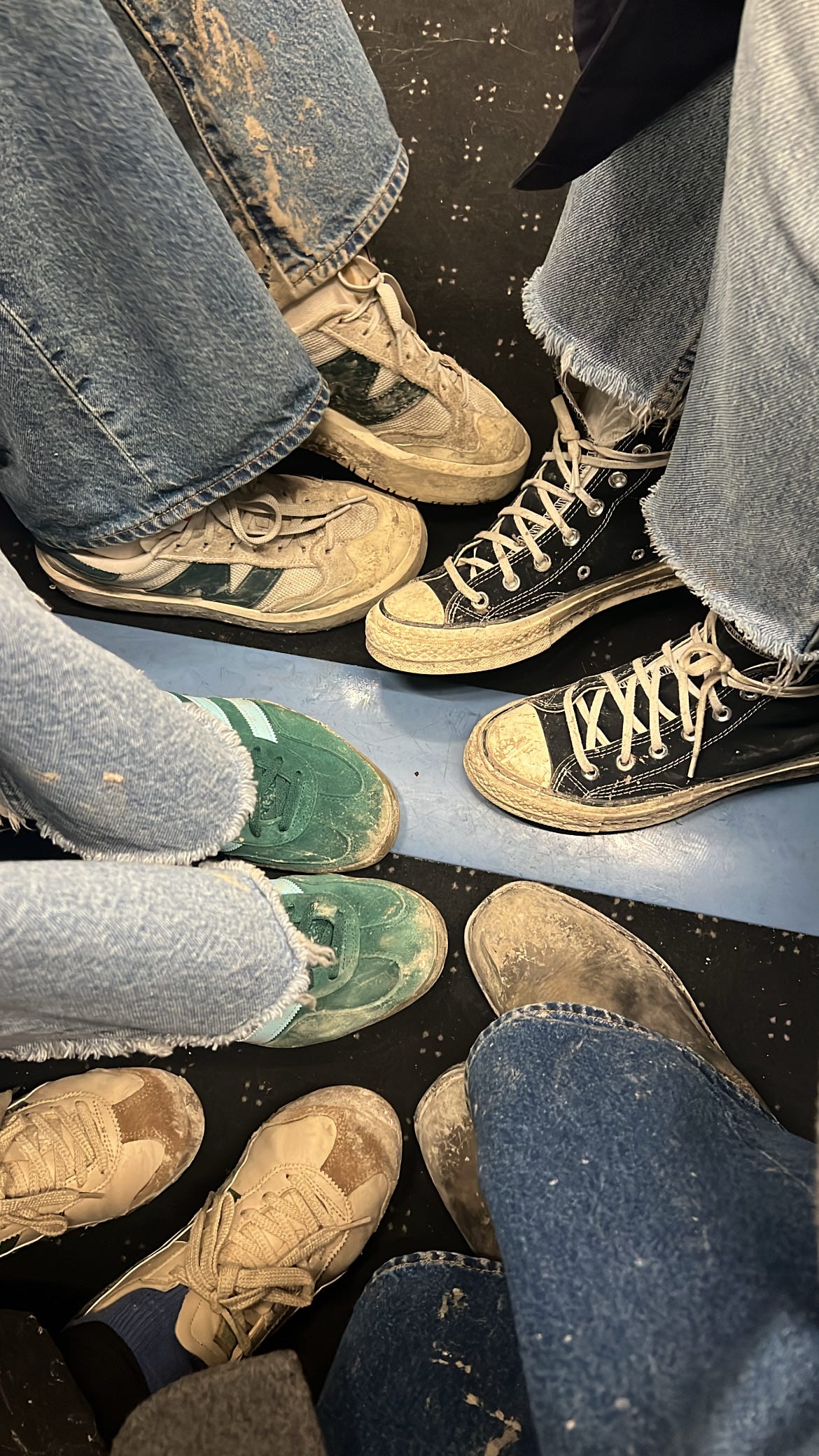
This is your best one yet, Allison. How great to fall in love with people you hardly know through a wonderful community from the past. The Bloomsbury group would be so pleased.
PSA: This substack discusses incredible height differences, it is, however, also outrageously funny.